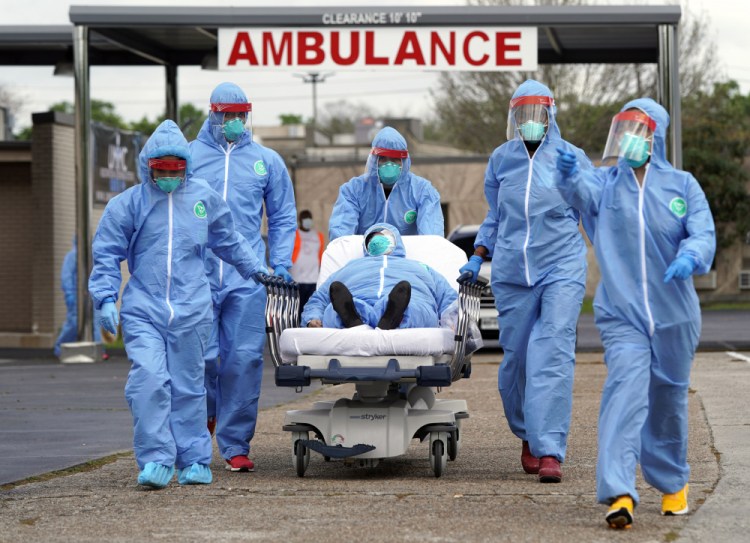The number of U.S. COVID-19 deaths has surpassed the toll of the 1918 influenza pandemic, a milestone many experts say was avoidable after the arrival of vaccines.
The U.S. has reported 675,446 deaths since the start of the pandemic, according to Johns Hopkins University data – more than the 675,000 that are estimated to have died a century earlier.
The U.S. hits that deadly mark despite the widespread availability of COVID-19 vaccines, which were developed in record time in a display of the extraordinary advances in medical science in the past century. The inoculations have been passed up by some 70 million eligible Americans, many of them encouraged by Republican politicians and conservative media.
“To have so many people who have died with modern medicine is distressing,” said Eric Topol, director of the Scripps Translational Research Institute, who noted there were no ventilators or vaccines in 1918. “The number we are at represents a number that is far worse than it should be in the U.S.”
The milestone also comes as the fast-spreading delta variant has pushed the U.S. into a dangerous new phase, upending hopes that the pandemic had passed and setting the stage for an uncertain winter.
Of course, the comparisons to the 1918 pandemic are highly imperfect. For starters, the U.S. has about three times as many residents as it had a century ago, meaning the implied death rate is about a third as high.
The 1918 pandemic also targeted many young people, whereas Covid has so far mostly killed those 65 and over, and the pandemics have played out at very different paces, according to John Barry, author of “The Great Influenza: The Story of the Deadliest Pandemic in History.” He said the 1918 pandemic did the majority of its damage during a 14- to 15-week stretch in the latter part of that year.
“That was much more intense, much more frightening,” Barry said of the earlier tragedy. But Barry said the stress from COVID has been longer-lasting, “and the economic damage is light-years greater.”

This photo shows a demonstration at the Red Cross Emergency Ambulance Station in Washington during the influenza pandemic of 1918. Historians think the pandemic started in Kansas in early 1918, and by winter 1919 the virus had infected a third of the global population and killed at least 50 million people, including 675,000 Americans. Library of Congress via AP
There are other reasons why the numbers may not reflect significant differences. The 675,000 estimate from 1918-19 was based on extrapolations from spotty data. While imperfect in their own ways, COVID-19 statistics are probably better.
During extreme events such as pandemics, experts use so-called excess death studies as one way to estimate fatalities – essentially comparing the number of deaths in the outlier period with “normal” times. One excess death estimate from the U.S. Centers for Disease Control and Prevention suggests there have been as many as 830,443 such fatalities during the COVID-19 pandemic, meaning the official numbers could be an undercount.
The unaccounted-for excess deaths may also reflect the price of disruptions in medical care and other indirect byproducts of the pandemic.
Vaccinations first rolled out in the U.S. in December and have been widely available for months. Since then, the vast majority of deaths have been among the unvaccinated.
“There is so much misinformation out there that some people cannot be convinced” of the benefits of vaccines, said Bertha Hidalgo, an epidemiologist at the University of Alabama. “Those are absolutely the deaths that can be prevented.”
A CDC study this month found that people who were not fully vaccinated this spring and summer were more than 10 times more likely to be hospitalized, and 11 times more likely to die of COVID-19, than those who were fully vaccinated. While delta’s spread has resulted in more cases among the vaccinated than many anticipated, the vaccine still protects well against severe illness.
Topol, the Scripps director, said the U.S. has failed in other ways. Mask use has declined significantly, and most people are still using cloth masks, which have shown to be much less effective than surgical and N95 masks. He said there needs to be widespread distribution of medical-grade masks and rapid at-home Covid tests that can help detect infections early on.
“Vaccines are a paramount part of the strategy, but we have failed on other measures as well,“ Topol said. “We’re fighting this war with two hands behind our back.”
Copy the Story LinkSend questions/comments to the editors.



Success. Please wait for the page to reload. If the page does not reload within 5 seconds, please refresh the page.
Enter your email and password to access comments.
Hi, to comment on stories you must . This profile is in addition to your subscription and website login.
Already have a commenting profile? .
Invalid username/password.
Please check your email to confirm and complete your registration.
Only subscribers are eligible to post comments. Please subscribe or login first for digital access. Here’s why.
Use the form below to reset your password. When you've submitted your account email, we will send an email with a reset code.